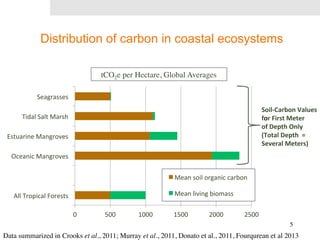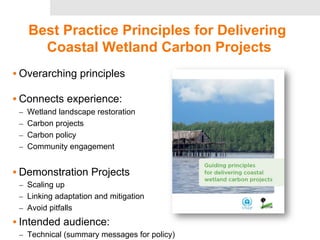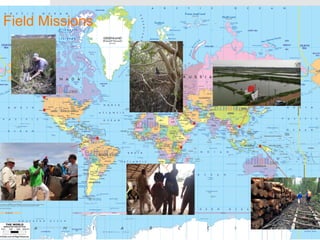Principles and Lessons Learned from Wetlands and Carbon Projects
- 1. Principles and Lessons Learned from Wetlands and Carbon Projects Steve Crooks Ph.D. Climate Change Program Manager Environmental Science Associates Best Practice Principles for Coastal Wetland Carbon Projects Side Event Indonesia Pavilion, COP 20, Lima December, 9th 2014 Jim Fourqurean
- 3. Contents • Why measure C stocks? • Field Campaign Planning • Sampling Soils • Sampling Vegetation • Estimating Emissions • Remote Sensing and Mapping • Data Management BlueCarbonInitiative.org
- 4. Ecosystem services of Coastal Blue Carbon ecosystems: mangroves, seagrass and marshes • Biological diversity • Water quality • Flood and storm protection • Forest and non-timber forest products • Aesthetic and ecotourism values • Fish and Shellfish • Carbon Sinks
- 5. Distribution of carbon in coastal ecosystems 5 0 500 1000 1500 2000 2500 Seagrasses Tidal Salt Marsh Estuarine Mangroves Oceanic Mangroves All Tropical Forests Mean soil organic carbon Mean living biomass Soil-‐Carbon Values for First Meter of Depth Only (Total Depth = Several Meters) tCO2e per Hectare, Global Averages Data summarized in Crooks et al., 2011; Murray et al., 2011, Donato et al., 2011, Fourqurean et al 2013
- 6. 5000 4500 4000 3500 3000 2500 2000 1500 1000 500 0 Tall Medium Dwarf Shrimp pond Mean Mangrove Carbon stock (CO2e Mg/ha) CARBON STOCKS OF NEOTROPICAL MANGROVES ARE AMONG THE LARGEST OF ALL TROPICAL FORESTS Ecosystem C stocks in CO2e, Republica Dominicana 2012 Kauffman et al. 2013) Abovegrd belowgd plant Downed Wood 0-15 15-30 30-50 50-100 >100
- 8. Coastal Blue Carbon Ecosystems 8 Mangroves Tidal Marshes Seagrass Forest Peatland
- 9. Best Practice Principles for Delivering Coastal Wetland Carbon Projects • Overarching principles • Connects experience: – Wetland landscape restoration – Carbon projects – Carbon policy – Community engagement • Demonstration Projects – Scaling up – Linking adaptation and mitigation – Avoid pitfalls • Intended audience: – Technical (summary messages for policy)
- 10. Project team • Steve Crooks PhD – Restoration Practice / Science • Igino Emmer PhD – Carbon Projects, Protocols • Moritz von Unger PhD – Carbon Projects, Legal • Ben Brown – Community Restoration • Daniel Murdiyarso PhD –Forestry / Peatland Science • Michelle Orr PE – Large-scale Restoration Planning
- 11. Reviewers • Verified Carbon Standard • Ministry for Marine Affairs and Fisheries, Indonesia • Duke University • Scientific and Technical Review Panel of Ramsar • Ramsar Secretariat • UNEP • Conservation International • UNEP-WCMC • Forest Carbon Markets and Communities Program
- 12. Report Content 1. Introduction 2. State of Knowledge on Coastal Blue Carbon 3. Lessons Learned from Prior Projects Wetlands Conservation and Restoration Carbon Project Development Community Engagement 4. Planning a Blue Carbon Project
- 13. Field Missions
- 14. The Learning Curve 1. Recognize value of coastal wetlands 2. Build experience in conservation & restoration projects 3. Establish multi-use functional landscape 4. Incorporated climate change adaptation (sea level rise) 5. Account for GHG emissions and removals.
- 15. Key Lessons • Wetland conservation offers greatest benefits • Highest GHG benefit, protect services, avoid engineering costs • Restoration of wetlands often technically feasible • Poor project planning cause of failure • Need for technology transfer and capacity building • Planning should incorporate sea level rise adaptation • tools exist • Link adaptation and mitigation • Community and national capacity required for success • No rigid template for blue carbon interventions
- 16. Mangroves / marshes occupy elevations above mid tide elevation
- 17. Lewis III & Brown, 2014
- 18. Plant mangroves in appropriate locations and they will thrive Premavera et al., 2012
- 19. Common mistake in coastal planning… Subsided drained former mangroves. Attempt to afforest mudflats. Not account for impacts of sea level rise. Increases long term vulnerability. Former mangrove edge. Now hard edge Temptation to plant mangroves on mudflat
- 20. Restore, but plan for the future
- 21. Lessons from Conservation and Restoration Planning 1. Have a clear and coherent planning approach 2. Plan conservation and restoration in the wider landscape context 3. Prioritize sites (not all are suitable) 4. Restore physical processes and ecosystem dynamics 5. Recognize the value of project design and engineering 6. Understand the restoration trajectory and ecological thresholds 7. Conserve and restore ecosystems sooner rather than later 8. Restoration of historic conditions is not always possible 9. Avoid transplantation of non-indigenous species 10. Be patient
- 22. Lessons learnt from carbon projects 1. Assume ownership of the project 2. Choose and demarcate the site(s) carefully 3. Choose the project standard and project delivery cycle 4. Access the market early 5. Link the project to other finance options 6. Check the costs and prepare for economies of scale
- 23. Lessons from community engagement 1. Invest in pre-project community capacity building • E.g. Field schools 2. Build capacity within government • National support • Subnational support 3. Meet in the middle • Train exensionists, • stakeholder communication 4. Establish livelihoods programs
- 24. Steps in Blue Carbon Project Planning 1. Define project concept and perform preliminary feasibility assessment. 2. Define target market and select a carbon standard 3. Establish effective community engagement 4. Design project activities 5. Assess permanence risk and develop mitigation strategy 6. Secure project development finance and structure agreements 7. Provide for legal due diligence and assess carbon rights 8. Provide for social and environmental impacts assessment 9. Maintain ongoing liaison with regulators.
- 25. ` 25 Stephen Crooks Climate Change Program Manager Environmental Science Associate +1 415 272 3916 [email protected]

























